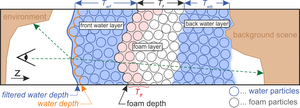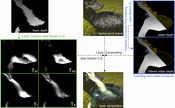Information
- Publication Type: Journal Paper with Conference Talk
- Workgroup(s)/Project(s):
- Date: June 2010
- Journal: Computer Graphics Forum (Proceedings EGSR 2010)
- Volume: 29
- Number: 4
- Location: Saarbrücken
- Lecturer: Florian Bagar
- ISSN: 0167-7055
- Event: Eurographics Symposium on Rendering 2010
- Conference date: 28. June 2010 – 30. June 2010
- Pages: 1383 – 1389
Abstract
We present a physically based real-time water simulation and rendering method that brings volumetric foam to the real-time domain, significantly increasing the realism of dynamic fluids. We do this by combining a particle-based fluid model that is capable of accounting for the formation of foam with a layered rendering approach that is able to account for the volumetric properties of water and foam. Foam formation is simulated through Weber number thresholding. For rendering, we approximate the resulting water and foam volumes by storing their respective boundary surfaces in depth maps. This allows us to calculate the attenuation of light rays that pass through these volumes very efficiently. We also introduce an adaptive curvature flow filter that produces consistent fluid surfaces from particles independent of the viewing distance.Additional Files and Images
Weblinks
BibTeX
@article{bagar2010,
title = "A Layered Particle-Based Fluid Model for Real-Time Rendering
of Water",
author = "Florian Bagar and Daniel Scherzer and Michael Wimmer",
year = "2010",
abstract = "We present a physically based real-time water simulation and
rendering method that brings volumetric foam to the
real-time domain, significantly increasing the realism of
dynamic fluids. We do this by combining a particle-based
fluid model that is capable of accounting for the formation
of foam with a layered rendering approach that is able to
account for the volumetric properties of water and foam.
Foam formation is simulated through Weber number
thresholding. For rendering, we approximate the resulting
water and foam volumes by storing their respective boundary
surfaces in depth maps. This allows us to calculate the
attenuation of light rays that pass through these volumes
very efficiently. We also introduce an adaptive curvature
flow filter that produces consistent fluid surfaces from
particles independent of the viewing distance.",
month = jun,
journal = "Computer Graphics Forum (Proceedings EGSR 2010)",
volume = "29",
number = "4",
issn = "0167-7055",
pages = "1383--1389",
URL = "https://www.cg.tuwien.ac.at/research/publications/2010/bagar2010/",
}


 draft
draft




